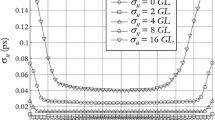Abstract
An approach to quantifying the errors in digital image correlation (DIC) is presented using experimentally produced images. The challenge arises in creating exact subpixel shifted images in an experiment. This was accomplished via numerical binning of an ultra-high resolution image. The shifted images are then used for a preliminary analysis of 2D correlation software uncertainty and investigation of speckle pattern quality. Because it is often necessary to use numerically shifted images, for uncertainty quantification for instance, the optimum method of Fourier shifting is also presented.


















Similar content being viewed by others
References
Schreier HW, Braasch JR, Sutton MA (2000) Systematic errors in digital image correlation caused by intensity interpolation. Opt Eng 39(11):2915–2921
Schreier HW, Sutton MA (2002) Systematic errors in digital image correlation due to undermatched subset shape functions. Exp Mech 42(3):303–310
Cheng P et al (2002) Full-field speckle pattern image correlation with B-spline deformation function. Exp Mech 42(3):344–352
Reu PL et al (2009) Uncertainty quantification for digital image correlation. In Society for Experimental Mechanics. SEM, Albuquerque
Pan B et al (2006) Performance of sub-pixel registration algorithms in digital image correlation. Meas Sci Technol 17(6):1615–1621
Orteu J-J et al. (2006) A speckle texture image generator. SPIE
Lava P et al (2009) Assessment of measuring errors in DIC using deformation fields generated by plastic FEA. Opt Lasers Eng 47(7–8):747–753
Wang YQ et al (2009) quantitative error assessment in pattern matching: effects of intensity pattern noise, interpolation, strain and image contrast on motion measurements. Strain 45(2):160–178
Wang ZY et al (2007) Statistical analysis of the effect of intensity pattern noise on the displacement measurement precision of digital image correlation using self-correlated images. Exp Mech 47(5):701–707
Reu PL (2010) Experimental validation of 2D uncertainty quantification for digital image correlation, in International Conference on Experimental Mechanics 14, F. Bremand, Editor. Poitiers, France
Kodak (2007) Kodak KAI-16000 image sensor—Device performance specifications. Kodak. p 10
Pan B et al (2008) Study on subset size selection in digital image correlation for speckle patterns. Opt Express 16(10):7037–7048
Stearns SD (2003) Digital signal processing with examples in MATLAB. CRC, Boca Raton
Hild F et al (2002) Multiscale displacement field measurements of compressed mineral-wool samples by digital image correlation. Appl Opt 41(32):6815–6828
Instruments N. Available from: http://zone.ni.com/reference/en-XX/help/371361F-01/lvanls/cosine_tapered_window/#details
Sutton DA, Orteu JJ, Schreier HW (2009) Image correlation for shape, motion and deformation measurements. Springer, New York
Acknowledgements
I would like to thank Prof. Mike Sutton and Dr. Hubert Schreier for many fruitful discussions on these results and their interpretation. I would also like to thank my reviewers David Epp and Timothy Miller for the valuable comments. This acknowledgement does not however, imply their complete agreement or endorsement of the interpretation of the results.
Sandia is a multiprogram laboratory operated by Sandia Corporation, a Lockheed Martin Company, for the United States Department of Energy under contract DE-AC04-94AL85000.
Author information
Authors and Affiliations
Corresponding author
Rights and permissions
About this article
Cite this article
Reu, P.L. Experimental and Numerical Methods for Exact Subpixel Shifting. Exp Mech 51, 443–452 (2011). https://doi.org/10.1007/s11340-010-9417-4
Received:
Accepted:
Published:
Issue Date:
DOI: https://doi.org/10.1007/s11340-010-9417-4




